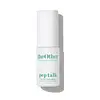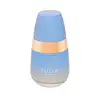What's inside
What's inside
 Key Ingredients
Key Ingredients

 Benefits
Benefits

 Concerns
Concerns

 Ingredients Side-by-side
Ingredients Side-by-side

Water
Skin ConditioningSqualane
EmollientAcetyl Octapeptide-3
HumectantPropanediol
SolventGlycerin
HumectantSodium PCA
HumectantCetearyl Alcohol
EmollientGluconolactone
Skin ConditioningGlyceryl Stearate
EmollientJojoba Esters
EmollientBakuchiol
AntimicrobialHippophae Rhamnoides Fruit Oil
Skin ProtectingXanthan Gum
EmulsifyingRosmarinus Officinalis Extract
AntimicrobialMelia Azadirachta Leaf Extract
Skin ConditioningLecithin
EmollientSclerotium Gum
Emulsion StabilisingPullulan
Helianthus Annuus Seed Wax
Skin ConditioningSodium Stearoyl Glutamate
CleansingMelia Azadirachta Flower Extract
Skin ConditioningCorallina Officinalis Extract
Skin ConditioningSodium Benzoate
MaskingSodium Phytate
Coccinia Indica Fruit Extract
Skin ConditioningCitrus Limon Fruit Extract
MaskingSolanum Melongena Fruit Extract
Skin ConditioningAloe Barbadensis Flower Extract
EmollientPolyglycerin-3
HumectantOcimum Sanctum Leaf Extract
Skin ConditioningOcimum Basilicum Flower/Leaf Extract
TonicCurcuma Longa Root Extract
MaskingTetrapeptide-30
Skin ConditioningPalmitoyl Tripeptide-5
Skin ConditioningWater, Squalane, Acetyl Octapeptide-3, Propanediol, Glycerin, Sodium PCA, Cetearyl Alcohol, Gluconolactone, Glyceryl Stearate, Jojoba Esters, Bakuchiol, Hippophae Rhamnoides Fruit Oil, Xanthan Gum, Rosmarinus Officinalis Extract, Melia Azadirachta Leaf Extract, Lecithin, Sclerotium Gum, Pullulan, Helianthus Annuus Seed Wax, Sodium Stearoyl Glutamate, Melia Azadirachta Flower Extract, Corallina Officinalis Extract, Sodium Benzoate, Sodium Phytate, Coccinia Indica Fruit Extract, Citrus Limon Fruit Extract, Solanum Melongena Fruit Extract, Aloe Barbadensis Flower Extract, Polyglycerin-3, Ocimum Sanctum Leaf Extract, Ocimum Basilicum Flower/Leaf Extract, Curcuma Longa Root Extract, Tetrapeptide-30, Palmitoyl Tripeptide-5
Water
Skin ConditioningGlycerin
HumectantSqualane
EmollientPropanediol
SolventBetaine
HumectantMethylheptyl Isostearate
Skin ConditioningUndecane
EmollientSodium Acrylates Copolymer
Niacinamide
SmoothingPolyglyceryl-4 Caprate
EmulsifyingTulipa Hybrid Flower Extract
Skin ConditioningTerminalia Ferdinandiana Fruit Extract
AntioxidantAstragalus Membranaceus Root Extract
EmollientAtractylodes Macrocephala Root Extract
Skin ConditioningBupleurum Falcatum Root Extract
Skin ConditioningHydrolyzed Hyaluronic Acid
HumectantCholecalciferol
Tocopherol
AntioxidantAscorbyl Glucoside
AntioxidantAllantoin
Skin ConditioningSodium Citrate
BufferingSodium Hyaluronate
HumectantSodium Gluconate
Skin ConditioningSodium Lactate
BufferingXylitylglucoside
HumectantAnhydroxylitol
HumectantXylitol
HumectantLecithin
EmollientTridecane
PerfumingAcacia Senegal Gum
MaskingSucrose
HumectantZea Mays Starch
AbsorbentCaprylic/Capric Triglyceride
MaskingGluconolactone
Skin ConditioningSodium Benzoate
MaskingCaprylyl Glycol
EmollientPotassium Sorbate
PreservativePhenethyl Alcohol
MaskingCalcium Gluconate
HumectantCitric Acid
BufferingSodium Hydroxide
BufferingMica
Cosmetic ColorantTitanium Dioxide
Cosmetic ColorantWater, Glycerin, Squalane, Propanediol, Betaine, Methylheptyl Isostearate, Undecane, Sodium Acrylates Copolymer, Niacinamide, Polyglyceryl-4 Caprate, Tulipa Hybrid Flower Extract, Terminalia Ferdinandiana Fruit Extract, Astragalus Membranaceus Root Extract, Atractylodes Macrocephala Root Extract, Bupleurum Falcatum Root Extract, Hydrolyzed Hyaluronic Acid, Cholecalciferol, Tocopherol, Ascorbyl Glucoside, Allantoin, Sodium Citrate, Sodium Hyaluronate, Sodium Gluconate, Sodium Lactate, Xylitylglucoside, Anhydroxylitol, Xylitol, Lecithin, Tridecane, Acacia Senegal Gum, Sucrose, Zea Mays Starch, Caprylic/Capric Triglyceride, Gluconolactone, Sodium Benzoate, Caprylyl Glycol, Potassium Sorbate, Phenethyl Alcohol, Calcium Gluconate, Citric Acid, Sodium Hydroxide, Mica, Titanium Dioxide
Ingredients Explained
These ingredients are found in both products.
Ingredients higher up in an ingredient list are typically present in a larger amount.
Gluconolactone is a PHA. PHAs are a great gentle alternative to traditional AHAs.
When applied, Gluconolactone has the same affect on skin as AHAs such as lactic acid. It helps dissolve the dead skin cells in the top layer of your skin. This improves texture and brightens the skin.
PHAs are more gentle than AHAs due to their larger structure. They do not penetrate as deeply as AHAs and take a longer time to dissolve dead cells. Studies show PHAs do not cause as much irritation.
Gluconolactone has some interesting properties:
In a 2004 study, Gluconolactone was found to prevent UV damage in mouse skin cells and has not been found to increase sun sensitivity. However, we still recommend wearing SPF daily.
This ingredient is is an created by reacting gluconic acid with an alcohol.
Learn more about GluconolactoneGlycerin is already naturally found in your skin. It helps moisturize and protect your skin.
A study from 2016 found glycerin to be more effective as a humectant than AHAs and hyaluronic acid.
As a humectant, it helps the skin stay hydrated by pulling moisture to your skin. The low molecular weight of glycerin allows it to pull moisture into the deeper layers of your skin.
Hydrated skin improves your skin barrier; Your skin barrier helps protect against irritants and bacteria.
Glycerin has also been found to have antimicrobial and antiviral properties. Due to these properties, glycerin is often used in wound and burn treatments.
In cosmetics, glycerin is usually derived from plants such as soybean or palm. However, it can also be sourced from animals, such as tallow or animal fat.
This ingredient is organic, colorless, odorless, and non-toxic.
Glycerin is the name for this ingredient in American English. British English uses Glycerol/Glycerine.
Learn more about GlycerinLecithin is a term for a group of substances found in the cell membranes of plants, animals, and humans. They are made up of mixture of phospholipids.
This ingredient has emollient and emulsifying properties.
As an emollient, lecithen helps soften the skin and creates a barrier to keep moisture in.
As an emulsifier, it also helps prevent water and oil ingredients from separating. Lecithin can also help ingredients be better absorbed by the skin.
This is because the phospholipids in lecithin produce liposomes. Liposomes help other ingredients get through the skin barrier.
Depending on the source of this ingredient, lecithin may not be fungal acne safe. This is because some sources of lecithin come from soybean oil, which may feed the malassezia yeast that feeds fungal acne.
We recommend reaching out to the brand you are purchasing from to inquire about the source of their lecithin.
Some other names for this ingredient include soy lecithin and deoiled soy lecithin.
Learn more about LecithinPropanediol is an all-star ingredient. It softens, hydrates, and smooths the skin.
It’s often used to:
Propanediol is not likely to cause sensitivity and considered safe to use. It is derived from corn or petroleum with a clear color and no scent.
Learn more about PropanediolSodium Benzoate is a preservative. It's used in both cosmetic and food products to inhibit the growth of mold and bacteria. It is typically produced synthetically.
Both the US FDA and EU Health Committee have approved the use of sodium benzoate. In the US, levels of 0.1% (of the total product) are allowed.
Sodium benzoate works as a preservative by inhibiting the growth of bacteria inside of cells. It prevents the cell from fermenting a type of sugar using an enzyme called phosphofructokinase.
It is the salt of benzoic acid. Foods containing sodium benzoate include soda, salad dressings, condiments, fruit juices, wines, and snack foods.
Studies for using ascorbic acid and sodium benzoate in cosmetics are lacking, especially in skincare routines with multiple steps.
We always recommend speaking with a professional, such as a dermatologist, if you have any concerns.
Learn more about Sodium BenzoateSqualane is an emollient that helps the skin hold onto moisture. It's an oily liquid that occurs naturally in certain types of fish and plant oils.
Because squalane boosts hydration in the skin, it also comes with plenty of benefits: it is an antioxidant and can help fight free radicals and skin damage. Squalane is also found to have a detoxifying effect when applied.
Squalane comes from squalene, which occurs naturally within the sebum of our skin. It is one of the oils our skin produces to keep itself hydrated. Squalane is the hydrogenated version of squalene and has a longer shelf life.
Research shows that squalane is non-irritating (even at 100% concentration).
In general, it's a fantastic ingredient. It does a great job at hydrating the skin, and it's suitable for those with sensitive skin.
The source of squalane may impact malassezia / fungal acne. This is because olive oil derived squalane can contain impurities such as fatty acids and plant waxes. Sugarcane derived squalane is recommended for anyone with malassezia concerns.
Is squalane vegan?
This depends on the source. Squalane can be derived from both plants and animals. Most squalane used in skincare comes from plants.
Please note: the source of squalane is only known if disclosed by the brand. We recommend reaching out to the brand if you have any questions about their squalane.
Read more about squalene with an "e".
Is squalane an oil?
Squalane is often called an oil, but it’s technically not; it’s a hydrocarbon, meaning it’s only made of carbon and hydrogen, unlike true oils which are triglycerides made of fatty acids and glycerol.
The term “oil-free” isn’t regulated, so companies can define it however they want. Some exclude all oils, while others just avoid mineral oil or comedogenic oils.
While some people avoid oils thinking they cause breakouts, the right kind of oil (or oil-like ingredient like squalane) can actually help balance and hydrate your skin. It’s worth testing out simple oils or squalane to see what works best for your skin.
Learn more about SqualaneWater. It's the most common cosmetic ingredient of all. You'll usually see it at the top of ingredient lists, meaning that it makes up the largest part of the product.
So why is it so popular? Water most often acts as a solvent - this means that it helps dissolve other ingredients into the formulation.
You'll also recognize water as that liquid we all need to stay alive. If you see this, drink a glass of water. Stay hydrated!
Learn more about Water